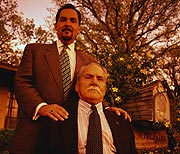
TUESDAY, Oct. 8 (HealthDay News) — Seniors and middle-aged adults die more often when the economy kicks into high gear than when their nation is spiraling toward recession, a new analysis contends.
The findings left the researchers scratching their heads. Factors like increased work stress and traffic accidents caused by more employed commuters on the roads cannot fully explain the trend, they noted. And while the study found an association between economic prosperity and increased mortality rates in these age groups, it did not prove a cause-and-effect link.
Previous studies have shown that mortality rates among people aged 18 to 65 increase when unemployment figures improve, said study author Herbert Rolden, a researcher at the Leyden Academy on Vitality and Ageing, in the Netherlands.
“We were very surprised to see that there is also a parallel movement between economic growth and mortality in the older population,” Rolden said. “It was highly unexpected, as the only solid explanation given in former studies focusing on the younger population was work stress. Now that we found that retirees also have an increased mortality risk in good economic times, we are still in the dark on what really explains the association.”
Researchers analyzed the gross domestic product (GDP) of 19 developed countries across the globe from 1950 to 2008, and then compared their economic findings against the death rates of people 40 to 44 years old and 70 to 74 years old.
They found that, on average, death rates rise by 0.36 percent among senior men and by 0.38 percent among middle-aged men for every one-percentage-point increase in GDP. Their report was published online Oct. 7 in the Journal of Epidemiology and Community Health.
Women suffered a similar, but lesser, effect. The death rate rose by 0.18 percent among those in their 70s, and by about 0.15 percent among those in their 40s.
Over the long term, an increase in GDP was associated with a fall in death rates in all 19 countries. However, economic cycles of relative boom and bust told a different story — when economies were expanding, death rates increased for both middle-aged and older people, but they fell when economies were heading for recession.
In their paper, the researchers tossed out these possible explanations and their limitations:
- Increased job stress could account for more middle-aged deaths, but wouldn’t affect seniors.
- Air pollution increases when economies are thriving, but that doesn’t explain why the death rate increases more in men than women.
- People are more likely to pursue unhealthy lifestyles and risky pursuits during good times, but these are unlikely to fully explain the trends.
The best explanation for the increase in senior mortality during boom times might be social, Rolden said.
When the economy is roaring, more people are put to work and there are fewer folks left around to care for the elderly.
“Although we think that the lack of social support in good economic times might explain the counterintuitive finding, as a good social network is highly beneficial for the survival of older people, this still remains to be studied,” Rolden said. “For older men, the association is strongest in Southern European countries — France, Spain, Portugal, Italy — as well as Austria and Australia. One could argue that older people are more dependent on informal care and social support in the Southern European countries, increasing their mortality risk when their children become employed or start to work longer.”
One expert agreed that the caretaking issue might be a critical factor in higher death rates.
“When looking at the older population and the increase in death rates, it becomes more obvious that the trend could be due to the roles of the caretaker,” said Dr. Suzanne Steinbaum, a preventive cardiologist at Lenox Hill Hospital, in New York City. “In light of these interesting trends, and the unclear nature of how all aspects of job employment can affect lifestyle, especially for the elderly, more research needs to be done.”
A couple of other factors might explain the increase in death rate, said Abdulrahman El-Sayed, a researcher in the department of epidemiology at Columbia University, in New York City.
One might be that seniors’ budgets become pinched in a hot economy. “If your income is fixed, as it for elderly adults, then the value of your dollar is potentially lower in a good economy,” El-Sayed said.
It might also be that people are dying at the same rate, but the folks who keep an eye on the death rate are better-funded, he said.
“You could see potential improvements in reporting. The economy gets better, and there’s more funding for the public health departments that collect this data. You might consider there’s more robust collection when the economy is strong,” El-Sayed said.
But he does believe the study’s authors are onto something when they talk about the social costs of success. The middle-aged folks suffer due to work stress and other factors related to employment, and the seniors suffer because the middle-aged are away at work and unable to care for them.
“The implication for the average individual is that it’s really important to remember that the value of the dollar isn’t the only value we care about. When we think about that extra hour at work, we have to weigh that against other things we value like time spent with our family,” El-Sayed said. “The cost of that extra dollar might be one’s health.”
More information
The American Psychological Association offers tips on managing your stress in tough economic times.
Copyright © 2025 HealthDay. All rights reserved.

